
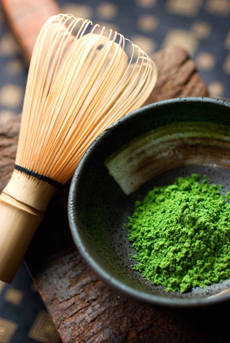 Matcha, green tea powder, is mixed in a chawan vessel with a chasen, or bamboo whisk. In Dr. Weil’s new tea line, you can buy matcha loose or blended in tea bags. Photo by Kelly Cline | IST. Matcha, green tea powder, is mixed in a chawan vessel with a chasen, or bamboo whisk. In Dr. Weil’s new tea line, you can buy matcha loose or blended in tea bags. Photo by Kelly Cline | IST.
|
KAREN HOCHMAN is Editorial Director of THE NIBBLE.
|
August 2007
|
 |
Dr. Andrew Weil For Tea
Tea Health Benefits, Snappily Packaged
CAPSULE REPORT: Dr. Andrew Weil, a pioneer in integrative medicine, and Ito En, the world’s largest purveyor of green tea, have collaborated on a line of green tea-centered products that look at tea not just as a beverage with health benefits, but as a health-focused food. It’s a repositioning of tea under Dr. Weil’s brand, but the teas, like all Ito En products, are top quality. There are brewed teas in a can that can be drunk iced, loose tea, tea bags and turmeric powder. While the brewed teas are high quality and most refreshing, they have no greater health benefit than Ito En’s Teas’ Tea line, which offers twice the tea for the same price—although the slender, 8.2 ounce can is very handsome packaging. Ito-En’s intense Sencha Shot, also in an 8.2 ounce can (not so handsome, but exhilarating flavor) has five times the antioxidants. But, Dr. Weil For Tea has panache, and we’d be proud to offer them to any guest. Most special in this line is the turmeric tea, a caffeine-free spice tea which can be served as an exotic, non-alcoholic apéritif (add a lime wedge).
Dr. Andrew Weil wants you to inteagrate your life. The doctor, who has lived in Japan and visits there frequently, has collaborated with Japanese tea producer Ito En, the world’s largest purveyor of green tea, to launch a line of premium teas that are handsomely packaged and promote a holistic lifestyle. If you don’t know Dr. Weil, he is a world-renowned leader and pioneer in the field of integrative medicine, medicinal plants, mind-body interactions and the future of medicine and health care. He was one of the first medical authorities to establish a beachhead on the Internet (DrWeil.com). His books include the national bestsellers Spontaneous Healing, 8 Weeks to Optimum Health, Eating Well for Optimum Health, The Healthy Kitchen: Recipes for a Better Body, Life, and Spirit and Healthy Aging: A Lifelong Guide to Your Physical and Spiritual Well-Being.
Tea is the world’s second most consumed beverage, after water. While there are more than 3,000 varieties of tea—stemming from different processing techniques—all tea comes from a single plant, Camellia sinensis, which first grew wild on tall shrubs in China. The Chinese began cultivating and trading tea more than 2,000 years ago, refining it over the centuries. At first leaves were boiled; later they were ground into a powder and whisked into a frothy elixir (the style known as matcha, which was brought back to Japan by visiting Japanese monks). Beginning a few centuries ago, carefully processed leaves were infused in steaming water. Today, most tea, whether loose or in bags, is prepared as an infusion. Tea grown in different environments—India and Japan, for example—and processed in different ways, accounts for the 3,000 varieties.
Tea has been used medicinally for more then 1,000 years, so it is not surprising that the most prominent practitioner of integrative medicine has put his name on a line of tea. What is surprising is that it’s taken this long for anyone to market tea as a functional food outside of health food stores—that is, a food that has health benefits beyond the reasons for which we consume it. Here, as part of Dr. Weil’s integrative approach to health, he recommends drinking tea as protection against disease, using the platform that scientific research studies have been bearing out—that the catechins (antioxidants) in tea are potent anti-carcinogens and fight other diseases as well.
The Health Properties Of Tea
More than a millennium ago, Chinese medical practitioners intuitively knew what recent clinical research studies have confirmed: Tea is beneficial to health and wellness. Tea contains naturally-occurring chemical compounds called catechins, a class of polyphenols also found in red wine. Catechins are potent antioxidants, fighting the dangerous radicals throughout the body. Their are four catechins in tea, one of which, EGCG (epigallocatechin gallate), is believed to be the most powerful anti-carcinogen. Studies also show that catechins also may fight heart disease by lowering cholesterol and improving lipid metabolism. White and green tea, because they are not oxidized like oolong and black teas, contain the highest levels of catechins.
Catechins are just one of the beneficial chemical compounds in tea. Here is the full “menu”:
Caffeine
- Promotion of wakefulness
- Eases fatigue and sleeplessness
- Diuretic effect
Catechins
- Anti-tumorigenesis (tumor growth)
- Antioxidant effect
- Inhibition of hypertension
- Antihypercholestolemia
- Hypoglycemic effect
- Anti-microbial activity
- Prevention of halitosis
- Scavenges free radicals
Carotene
Flavonoids
- Strengthening of blood vessels
- Prevention of halitosis
Fluoride
Polysaccharides
|
Saponins
- Anti-fungal activity
- Anti-inflammatory
- Anti-allergenic activity
- Anti-obesity
Theanine
- Calms effects of caffeine
- Inhibition of hypertension
- Improvement of brain function
Vitamin C
- Antioxidant effect
- Prevention of flu
- Health maintenance of skin and
mucous membranes
- Radical scavenging effect
Vitamin E
- Antioxidant effect
- Health maintenance of cells
- Radical scavenging effect
y-Amino Butyric Acid
- Inhibition of hypertension
|
Varieties Of Tea
In selecting teas for his line, Dr. Weil chose loose leaf and bagged teas, but began with a line of elegant, grab-and-go iced teas, the fastest-growing area of the tea category. Initially, there are five brewed teas in cans:
The canned teas are brewed with purified water and have added vitamin C as a preservative. In fact, each can has at least 100% of the daily value, based on a 2,000 calorie diet; and most varieties have almost double that. The color of all of the brewed teas is in the gold spectrum, from pale gold to rosy gold—showing that just because tea is black, green or white does not mean the liquor will be reddish-brown, green or pale.
Darjeeling Tea
Darjeeling—meaning “Land of the Thunderbolt,” is a black tea grown in the Darjeeling area of northern India, on the foothills of the Himalayas, at altitudes up to 7,000 feet above sea level. Called “the Champagne of Indian teas” for its quality, fragrance and sophistication of flavor, it is light in color with a delicate, muscatel flavor and aroma and a crisp astringency. Black teas are fully oxidized, accounting for the stronger, more robust taste which can be enjoyed with milk and sugar—however, the milk proteins cancel out the beneficial effects of the catechins. Connoisseurs enjoy fine black tea as is, without added dairy or sweeteners. While black tea has the highest caffeine content of all of categories of tea, it still contains only half the caffeine of coffee. The caffeine’s effects are also balanced by theanine—present in all tea varieties—a naturally-occurring amino acid known for its calming properties. |
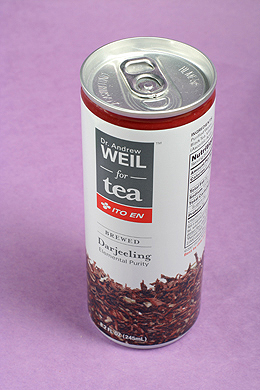
Darjeeling, a district in India, produces a black tea that has long been prized by the British. Can photos by Michael Steele. |
Even iced, you can taste the fruity muscatel in this Darjeeling (cold will dampen the flavor of any beverage, so the properties of fine tea reveal themselves better in the hot drink). Its deep, rosy gold color is the darkest of all the brewed teas—not surprising since Darjeeling is the only black tea, and black teas brew darker than oolong, green or white. (There are no oolongs in this collection.)
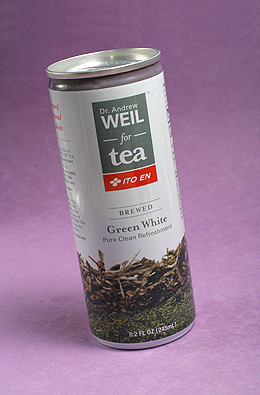
Green White has the highest levels of antioxidants.
|
Green White Tea
Delicate-flavored white tea has even more antioxidants than green tea; here green is blended in to provide flavor. To halt the oxidation process, leaves are either steamed (Japan) or pan-fired (China). By exposing the leaves to heat, the enzyme responsible for oxidation is eliminated. This steaming or firing is done shortly after picking and gives green tea its signature herbaceous taste. Green tea has become much more popular in recent years because of the studies showing the connection between its high concentration of antioxidants and the ability of antioxidants to fight free radicals. The flavor, called “pure clean refreshment,” is light and crisp, with a lovely herbaceous quality and pleasantly bitter tannins. The color is a strong gold, like apple juice or Chardonnay.
|
Gyokuro Green Tea
Gyokuro, meaning “jade dew,” is Japan’s most prized tea. It is a shade-grown tea, producing a fine and expensive grade of the green tea known as sencha. Its name, jade dew, refers to the pale green color of the infusion. It is a special tea, requiring a brewing technique different from sencha: a lower water temperature and more tea in the infusion. People who don’t realize this spend the money for gyokuro, only to end up with an average cup of tea. It is traditionally served to honored guests, and this brewed, canned version is an unusual opportunity for most people to taste gyokuro. “Deep, rich, and vital,” promises the can. The taste is vegetal and earthy, with no discernable tannins. The color is a pale gold, like Sauvignon Blanc. |
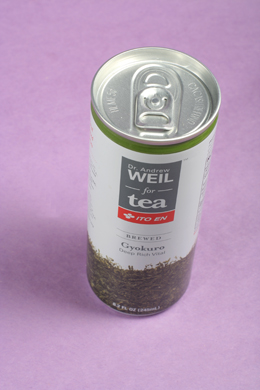
Gyokuro is a special, costly tea. When brewed
from leaves, a different technique is required. |
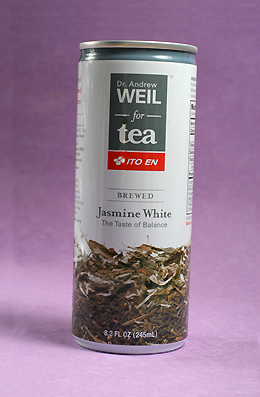
Jasmine White is the “calming tea.”
|
Jasmine White Tea
Here, fragrant jasmine is added to the green-white blend. Both jasmine and white tea have been treasured in China for centuries for their calming properties. White tea is the most untouched of teas: The leaves are dried gently and naturally, exposed only to light and air. This method retains the highest levels of antioxidants. The flavor is the most subtle of all teas, characteristically light and delicate. Centuries ago, the pure simplicity of white tea gained it a privileged place in the imperial court of China's Song Dynasty. The tea is lightly scented flavored with jasmine—we, who love jasmine tea, would have asked for a heavier hand. The color is a rosy gold.
|
- Turmeric Tea. Turmeric is not Camellia sinensis, but an herbal (or in this case, spice) tea, traditionally drunk as a restorative tea in Okinawa, the Japanese island famed for health and longevity. This vibrant spice from the ginger family is now attracting the attention of Western science for its numerous health benefits. Curcumin, the substance that gives turmeric its yellow color, has compounds that laboratory studies indicate have potential health benefits, from cancer-fighting powers to the ability to block the progression of multiple sclerosis. Curcumin is beneficial in reducing damage to heart tissue from lack of oxygen or blood flow and may be helpful in inhibiting the multiplication of leukemia cells. It seems to protect against damage caused by cigarette smoke and eating certain processed foods.
|
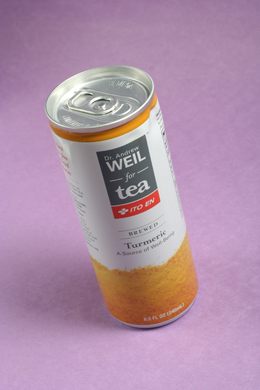
This herbal tea is brewed from the spice, turmeric, which is being investigated for its health benefits. |
Not surprisingly, Turmeric Tea was the purest yellow in color, with the attractive scent of turmeric. It tasted like turmeric, too—or, like an Indian beverage. The taste is exotic, but attractive. Add some cracked ice and mint or a lime wedge, and serve this one as a non-alcoholic apéritif. (You can purchase the powder separately and brew it yourself.)
Loose Leaf Tea
Loose tea is available in “premium” and “everyday” varieties, based on the quality of the leaves. The premium teas are packaged in airtight canisters, the everyday teas in paper pouches.
Premium Teas
- Jasmine Pearl. Skilled artisans hand-roll green tea leaves into pearls, which are
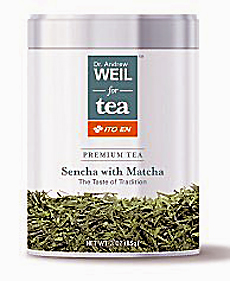 then immersed in the scent of jasmine blossoms. When immersed in hot water, the pearls unfurl and create an aromatic, calming fragrance with a delectable floral flavor. then immersed in the scent of jasmine blossoms. When immersed in hot water, the pearls unfurl and create an aromatic, calming fragrance with a delectable floral flavor.
- Matcha. Matcha is the style of tea originally brought to Japan from China by monks: Its stimulating properties (from the caffeine) were used by the monks to stay alert during long hours of meditation. The leaves are carefully shade grown, picked, steamed and ground by stone into a fine green powder (see the photo at the top). Matcha is the tea used in the traditional Japanese tea ceremony. It contains the highest amounts of essential vitamins and nutrients because the actual leaf is dissolved into the water and consumed.
- Genmaimatcha. A blend of green tea and roasted rice, this is one of the most popular teas in the world. When matcha is added, it takes on a vibrant green color. A lovely tea with complex flavors, the roasted rice provides a wonderful nutty taste (think roasted puffed rice).
- Sencha With Matcha. Here, premium green tea is infused with matcha. The result is a vibrant green color and a smooth taste, with a full flavor.
- White Peony. Cultivated in China’s Fujian province, the ancestral home of white tea, this variety is rich in antioxidants and contains minimal caffeine. The taste is gentle and smooth, yet well defined for a white tea. White Peony is one of the two most popular varieties of white tea. The other, Silver Needle, is a mild-flavored tea made exclusively from downy tea tips. White Peony mixes both the tips and larger leaves, for a fuller flavor.
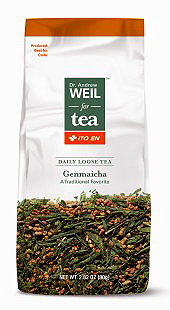
|
Everyday Teas
“Everyday” tea is perfectly delicious, but less fine than the premium tea line. It is available in the two most popular varieties:
- Genmaicha. A more basic version of the premium genmaimatcha above. It’s also available in tea bags.
- Sencha. Sencha is the most popular green tea in Japan—your basic, everyday green tea.
|
Mesh Tea Bags
For those who prefer the convenience of tea bags, there are four varieties. Two are blended with matcha, the prized, emerald-green powdered tea used in the traditional Japanese tea ceremony.
-
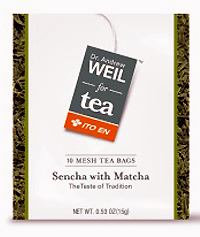 Darjeeling, a favorite black tea for morning and afternoon, elegant and aromatic with a hint of fresh muscat and a refreshing finish. Darjeeling, a favorite black tea for morning and afternoon, elegant and aromatic with a hint of fresh muscat and a refreshing finish.
- Genmaicha, the bag version of the loose tea available above.
- Jasmine Green Tea, with a beautiful floral fragrance, jasmine tea is drunk all day for its calming properties.
- Sencha With Matcha, green tea infused with matcha to produce a sparkling green tea with an invigorating flavor.
However you enjoy your tea, it’s calorie-free and chock-full of health.
Dr. ANDREW weil for tea
Assorted Tea Products
- Brewed Teas: Darjeeling, Green-White, Gyokuro, Jasmine,
Turmeric
Case of 30 8.2 fl oz cans
$48.20
Individual Cans Retail For
$1.79 to $1.99
- Loose Tea: Genmaicha, Sencha
2.82-Ounce Package, $7.99
- Premium Loose Tea:
Genmaimatcha, Jasmine,
Sencha, White Peony
3-Ounce Tin,
$9.99-$14.99
- Mesh Tea Bags:
Darjeeling,
Genmaimatcha, Jasmine, Sencha
Box Of 10 Bags, $6.99
- Turmeric Powder
10 Packets, $9.99
|
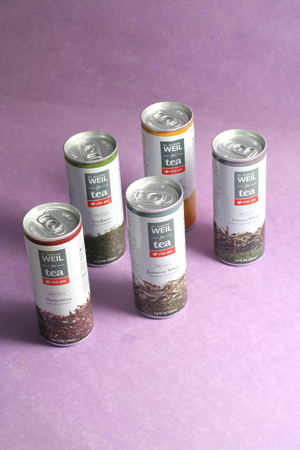 Photo by Michael Steele. Photo by Michael Steele.
|
Purchase online at ItoEn.com.
Available at fine retailers nationwide.
Prices and product availability are verified at publication but are subject to change. Shipping is additional.

|










 then immersed in the scent of jasmine blossoms. When immersed in hot water, the pearls unfurl and create an aromatic, calming fragrance with a delectable floral flavor.
then immersed in the scent of jasmine blossoms. When immersed in hot water, the pearls unfurl and create an aromatic, calming fragrance with a delectable floral flavor. 
 Darjeeling, a favorite black tea for morning and afternoon, elegant and aromatic with a hint of fresh muscat and a refreshing finish.
Darjeeling, a favorite black tea for morning and afternoon, elegant and aromatic with a hint of fresh muscat and a refreshing finish.